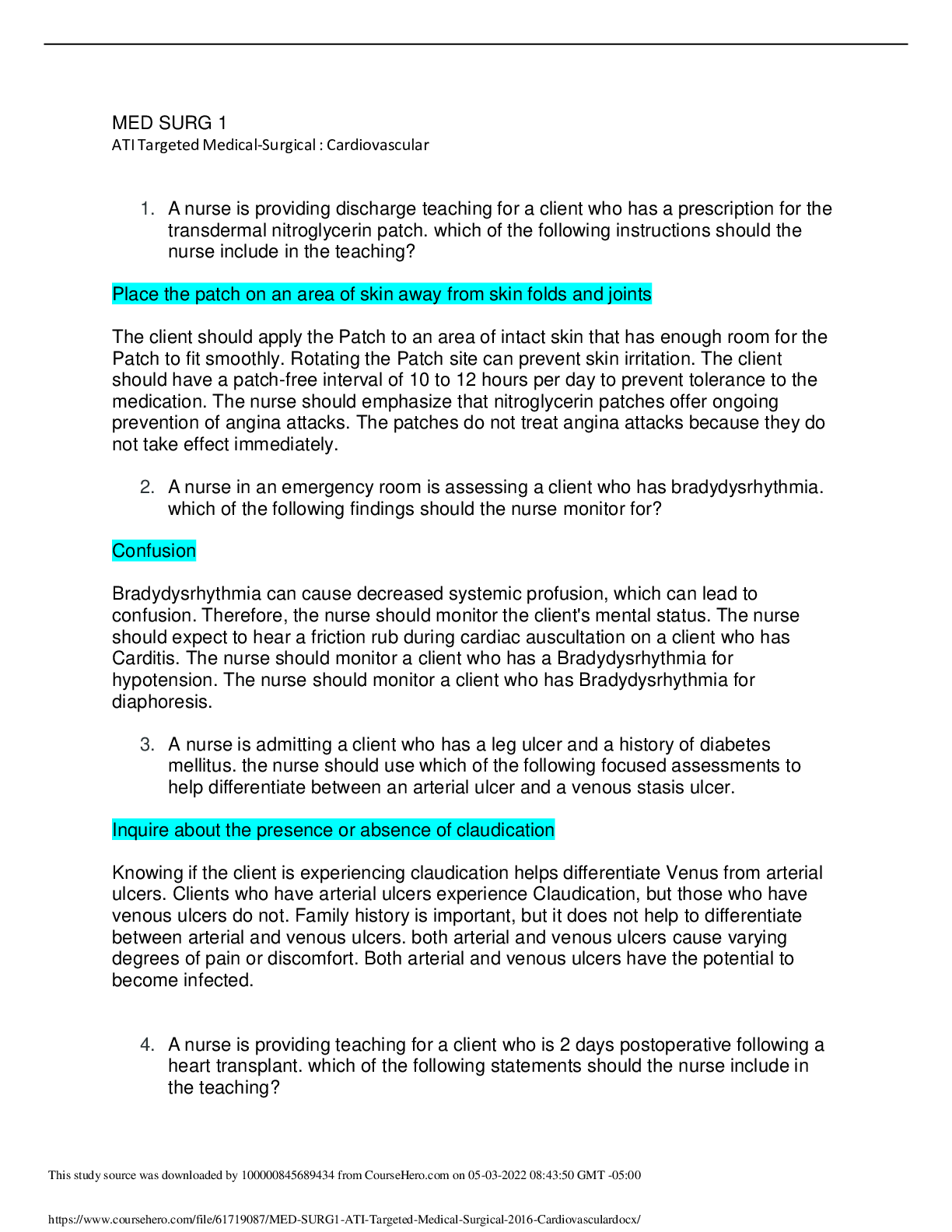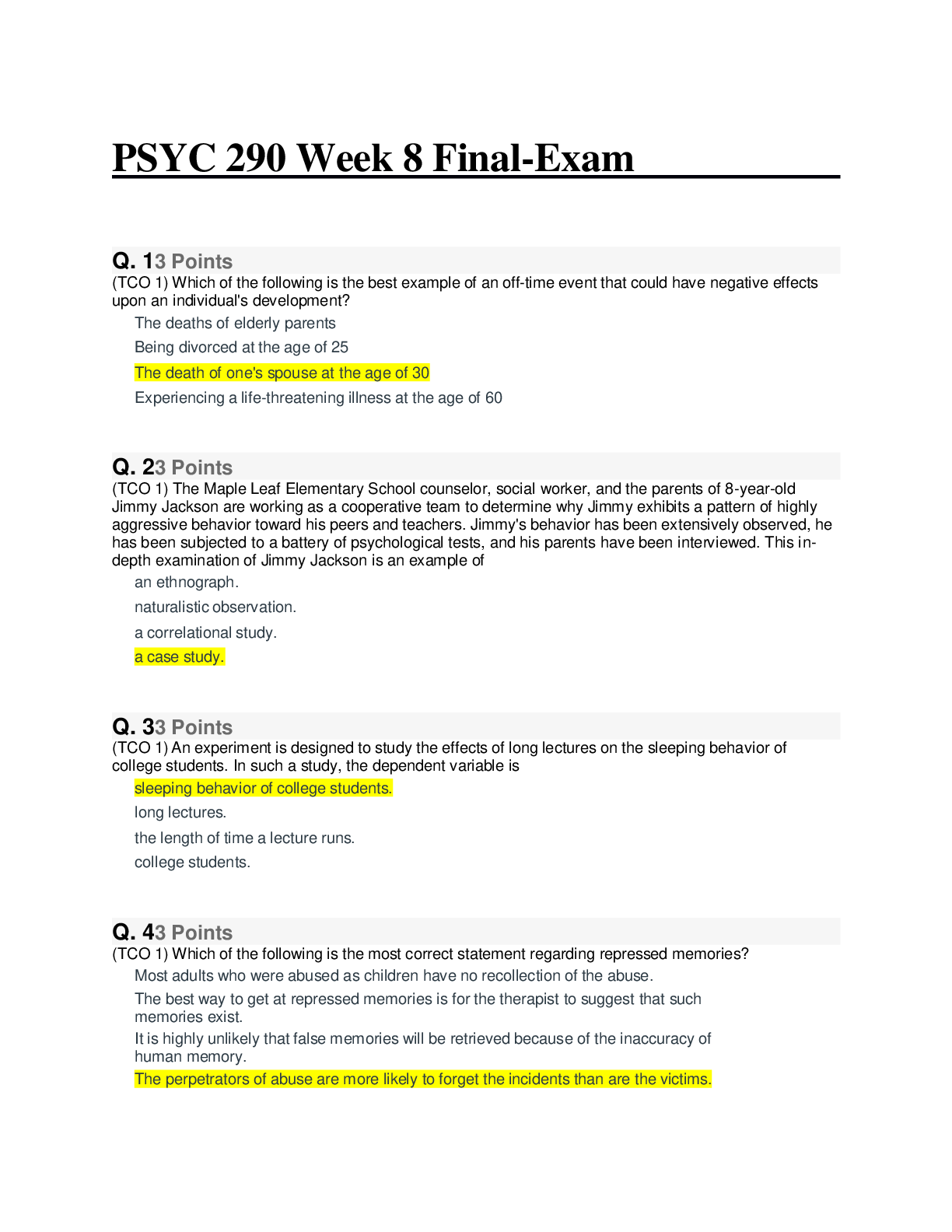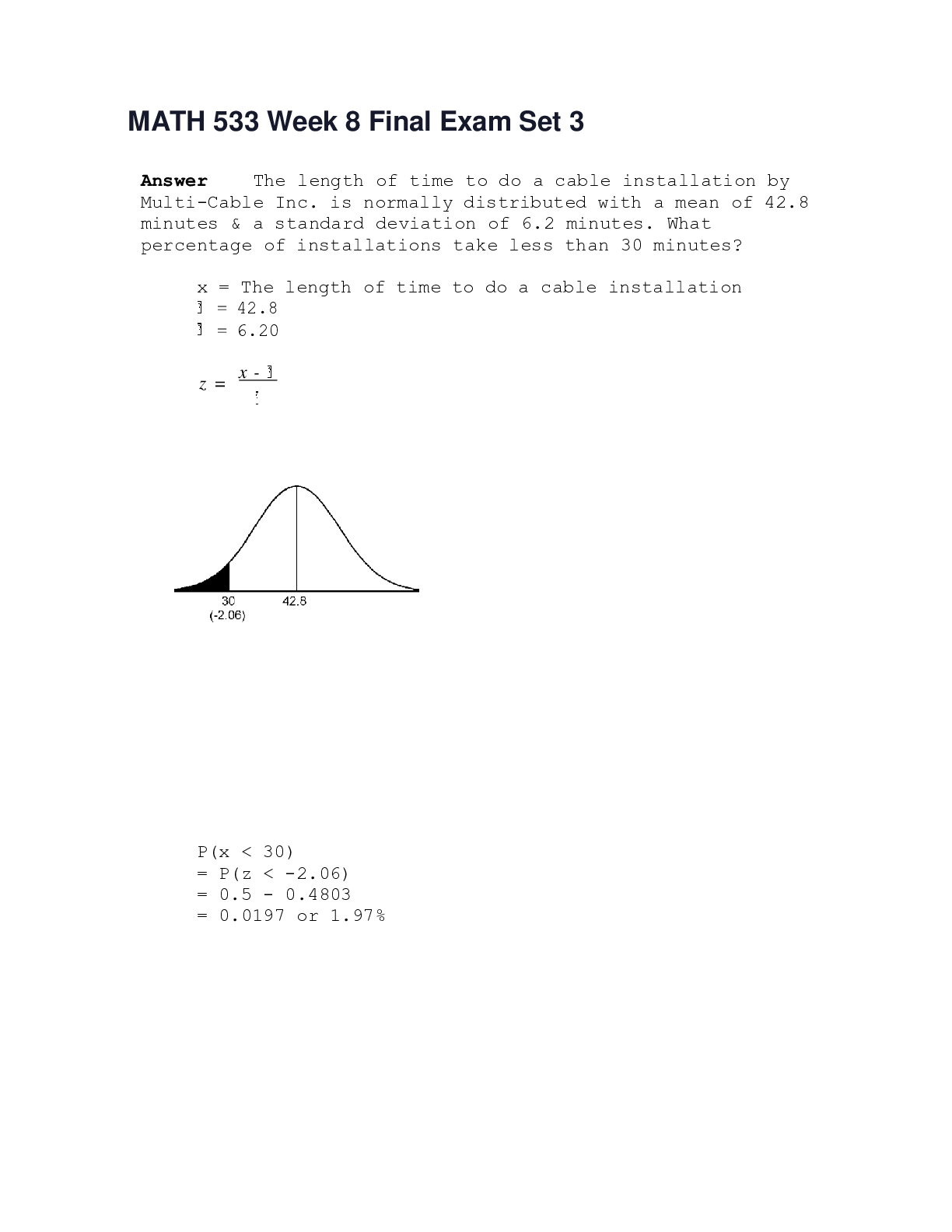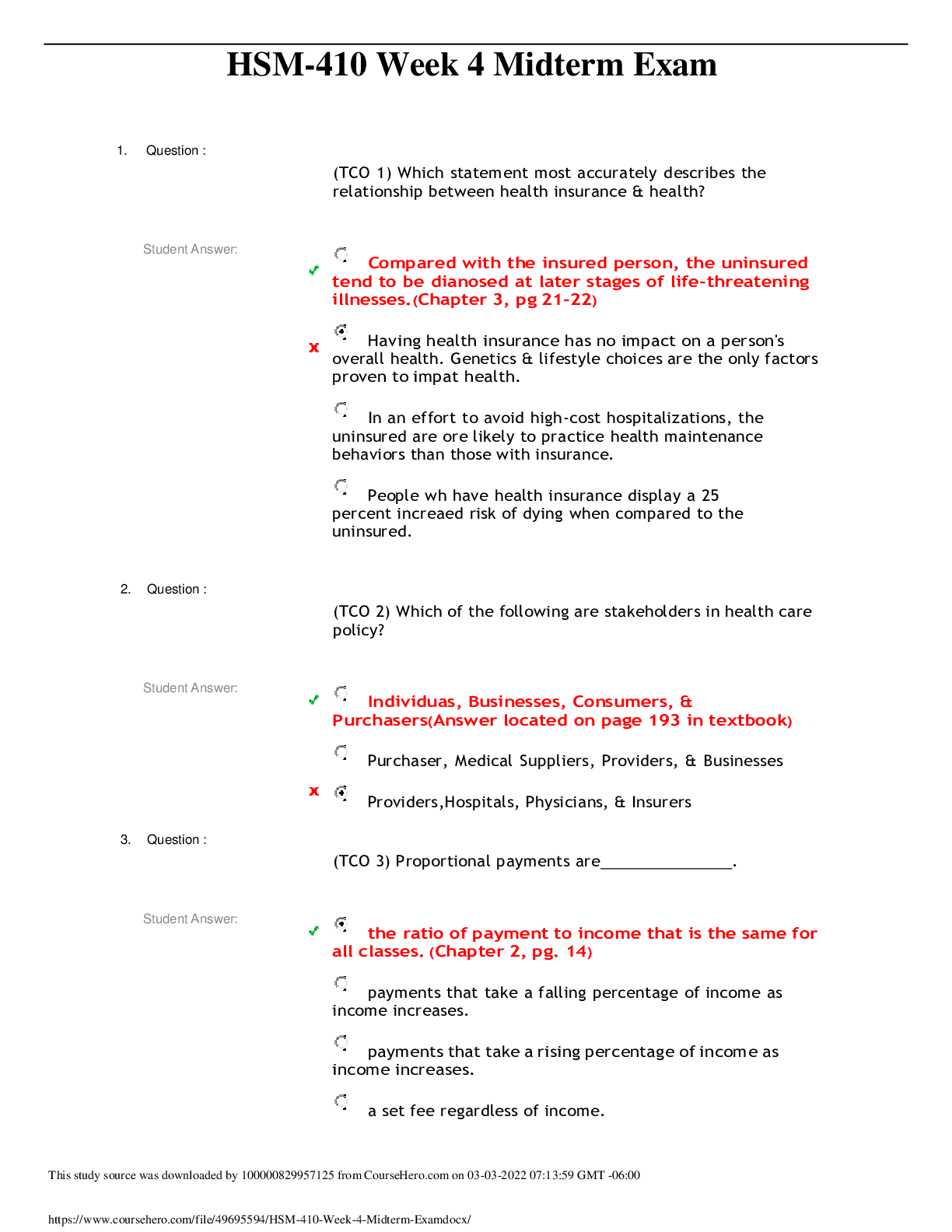ATI Targeted Medical-Surgical Cardiovascular TEST (100% Correct solution)
Document Content and Description Below
MED SURG 1 ATI Targeted Medical-Surgical : Cardiovascular 1. A nurse is providing discharge teaching for a client who has a prescription for the transdermal nitroglycerin patch. which of the fol... lowing instructions should the nurse include in the teaching? Place the patch on an area of skin away from skin folds and joints The client should apply the Patch to an area of intact skin that has enough room for the Patch to fit smoothly. Rotating the Patch site can prevent skin irritation. The client should have a patch-free interval of 10 to 12 hours per day to prevent tolerance to the medication. The nurse should emphasize that nitroglycerin patches offer ongoing prevention of angina attacks. The patches do not treat angina attacks because they do not take effect immediately. 2. A nurse in an emergency room is assessing a client who has bradydysrhythmia. which of the following findings should the nurse monitor for? Confusion Bradydysrhythmia can cause decreased systemic profusion, which can lead to confusion. Therefore, the nurse should monitor the client's mental status. The nurse should expect to hear a friction rub during cardiac auscultation on a client who has Carditis. The nurse should monitor a client who has a Bradydysrhythmia for hypotension. The nurse should monitor a client who has Bradydysrhythmia for diaphoresis. 3. A nurse is admitting a client who has a leg ulcer and a history of diabetes mellitus. the nurse should use which of the following focused assessments to help differentiate between an arterial ulcer and a venous stasis ulcer. Inquire about the presence or absence of claudication Knowing if the client is experiencing claudication helps differentiate Venus from arterial ulcers. Clients who have arterial ulcers experience Claudication, but those who have venous ulcers do not. Family history is important, but it does not help to differentiate between arterial and venous ulcers. both arterial and venous ulcers cause varying degrees of pain or discomfort. Both arterial and venous ulcers have the potential to become infected. 4. A nurse is providing teaching for a client who is 2 days postoperative following a heart transplant. which of the following statements should the nurse include in the teaching? "You might no longer be able to feel chest pain" Heart transplant clients usually are no longer able to feel chest pain due to the denervation of the heart. the client's activity tolerance should get gradually improved as the healing process progresses. The client will need to permanently maintain a diet that is restricted in sodium and fat. The client will remain on immunosuppressants for the remainder of his life to help prevent rejection of the heart. 5. A nurse is caring for a client who was admitted for a treatment of left-sided heart failure with intravenous loop diuretics and digitalis therapy. the client is experiencing weakness and an irregular heart rate. which of the following actions should the nurse take first? Review serum electrolyte Values weakness and irregular heart rate indicate that the client is at the greatest risk for electrolyte imbalance, an adverse effect of loop diuretics. the first action the nurse should take is to review the client's electrolyte values, particularly the potassium level, because the client is at risk for dysrhythmias for hypokalemia. The nurse should obtain the client's current weight to determine fluid loss from diuretic therapy. However, the nurse should take another action 1st. The nurse should determine the time of the last digoxin dose in order to evaluate when the next dose is due period however comma the nurse should take another action first. The nurse should check the client's urine output to determine fluid loss from diuretic therapy. However, the nurse should take another action first. 6. A nurse is assessing a client who has Left-Sided failure. which of the following manifestations should the nurse expect to find? Weak Peripheral Pulses Sweet peripheral pulses are related to decreased cardiac output resulting from left sided heart failure. Increased abdominal girth is a finding related to systemic congestion resulting from right sided heart failure. Jugular venous distention is a finding related to systemic congestion resulting from right sided heart failure dependent edema early morning for brothers to is a finding related to systemic congestion resulting from right sided heart failure. 7. A nurse is assessing a client who has a history of DVT and is receiving warfarin. the nurse should identify that which of the following findings indicates the mediation is effective? INR 2.0 Then there should identify there an INR of 2.0 is within the desired reference range of 2.0 to 3.0 for a client who has a deep vein thrombosis Ann is receiving warfarin to reduce the risk of new clap formation and a stroke . The nurse should recognize that the hemoglobin level of 14 g/dL is within the expected reference range however, it is not evidence of effective warfarin therapy. The nurse should recognize that minimal bruising or no bruising is desired. However, this is not evidence of effective warfarin therapy. then they should recognize that decrease blood pressure is a manifestation of bleeding comma which is an adverse effect of warfarin in therapy. 8. A nurse is preparing a client for coronary angiography. the nurse should report which of the following findings to the provider prior to the procedure? Previous allergic reaction to shellfish In contrast medium used is iodine based. Clients who have a history of allergic reaction to shellfish often react to iodine and may need a steroid or anti histamine. A hemoglobin level of 14.4 g/dL is within the expected reference range. This procedure involves access through large arteries or veins into the heart and is not affected by peripheral arterial disease. In output of 200 ML in 4 hours is within expected reference range. 9. A nurse in an emergency department s caring for a client who has a blood pressure of 254/139 mm hg. the nurse recognizes that the client is in a hypertensive crisis. which of the following actions should the nurse take first? elevate the head of the client's bed The greatest risk to this client is organ injury due to severe hypertension . Therefore, the first action the nurse should take is to elevate the head of the client's bed to reduce blood pressure and promote oxygenation. The nurse should initiate seizure precautions because the client is at risk for seizures. However, this is not the 1st action the nurse should take period the nurse should tell the client to report vision changes because the client is at risk for blurred vision. However, this is not the first action the nurse should take. The nurse should initiate an ID to provide access for medication administration to reduce the client's blood pressure. However, this is not the first action the nurse should take. 10. a nurse is reviewing the laboratory results of several male clients who have peripheral arterial disease. the nurse should plan to provide dietary teaching for the client who has which of the following laboratory values? Cholesterol 190, HDL 25, LDL 160 Expected reference range of cholesterol is less than 200 mg/dL, HDL above 45 mg/dL for men and above 55 mg/dL for women, and LDL less than 130 mg/dL. Total cholesterol levels less than 200 milligrams per deciliter (mg/dL) are considered desirable for adults. A reading between 200 and 239 mg/dL is considered borderline high and a reading of 240 mg/dL and above is considered high. LDL cholesterol levels should be less than 100 mg/dL. Levels of 100 to 129 mg/dL are acceptable for people with no health issues but may be of more concern for those with heart disease or heart disease risk factors. A reading of 130 to 159 mg/dL is borderline high and 160 to 189 mg/dL is high. A reading of 190 mg/dL or higher is considered very high. HDL levels should be kept higher. A reading of less than 40 mg/dL is considered a major risk factor for heart disease. A reading from 41 mg/dL to 59 mg/dL is considered borderline low. The optimal reading for HDL levels is of 60 mg/dL or higher. 11. A nurse is caring for a client who is scheduled for a coronary artery graft in 2 hours. which of the following client statements indicates a need for further clarification by the nurse? I took my warfarin last night according to my usual schedule Play into her scheduled for a CABG should not take anti coagulants, such as warfarin, for several days prior to the surgery to prevent excessive bleeding. The provider might have the client discontinue over-the-counter medications, such as aspirin, prior to surgery to reduce the risk of bleeding. The provider might instruct the client to administer medications to treat high blood pressure to reduce the risk of hypertension. The provider might instruct a client who takes insulin to get a reduced dose in the morning of surgery to regulate blood glucose. 12. A nurse is caring for a client following insertion of a permanent pacemaker. which of the following client statements indicates a potential complication of the insertion procedure? I cannot get rid of these hiccups Hiccups can indicate that the pacemaker is stimulating the chest wall or diaphragm, which can occur as a result of a lead wire perforation. Dizziness is not a complication of the insertion procedure an is expected initially as the client adjust to the pacemaker. Pain or stinging at the incision site is not a complication of the insertion procedure. However, the client should monitor the pacemaker insertion site for manifestations of infection. Headache is not a complication of the insertion procedure. However, it might be related to other disease processes. 13. A nurse is assessing a client who has pulmonary edema related to heart failure. which of the following findings indicates effective treatment of the client’s condition? Absence of Adventitious breath sounds Adventitious breath sounds occur when there is fluid in the lungs. The absence of adventitious breath sounds indicates that the pulmonary edema is resolving. A moist productive cough usually accompanies pulmonary edema. However, the presence of nonproductive cough does not indicate that the problem is resolving. The respiratory rate usually decreases while at rest it is not an indicator of effective treatment. This value of SaO2 86% on room air is below the expected reference range. It is not an indicator of effective treatment. 14. A nurse is caring for client who is receiving heparin therapy and develops hematuria. which of the following actions should the nurse take if the clients aPTT is 96 seconds? Stop the Heparin infusion the nurse should identify that the clients aPTT is above the critical value and the client is displaying manifestations of Bleeding. Therefore, the nurse should discontinue the heparin infusion immediately and notify the provider to reduce the risk of client injury. An aPTT of 96 seconds indicates excessive heparin period therefore the nurse should not increase the heparin infusion. The nurse should monitor PT for a client who is taking an oral anticoagulant. However, it is not necessary to request a PT before taking any corrective action. 15. A nurse is caring for a postoperative client 1 hr following an aortic aneurysm repair. which of the following findings can indicate shock and should be reported to the provider? Urine output of 20ml/hr Serosanguineous drainage one hour postoperative is expected and is not a manifestation of shock. Serosanguineous drainage should decrease over the first few days and discontinue after day five. Coffee is paid full after an aortic aneurysm repair period however it is not a manifestation of shock. Urine output less than 30 ml/h Is a manifestation of shock. Urine output is decreased due to a compensatory decreased blood flow to the kidneys, hypovolemia, or graft thrombosis or rupture. 38.8oC to 37.5oC is within the expected reference range and is not a manifestation of shock. 16. A nurse is teaching a client who is starting to take an ace inhibitor to treat hypertension . the nurse should instruct the client to notify his provider if he experiences which of the following adverse effects of this medication? Persistent Cough A persistent cough is an adverse effect of ACE inhibitors. The client should report this finding to the provider and discontinue the medication. Tendonitis is an adverse effect of fluoroquinolone antibiotics. Frequent urination is an expected outcome of this medication. Constipation is an adverse effect of ACE inhibitors. However, the client does not need to discontinue use or report this to the provider. 17. A nurse is caring for a client who has endocarditis. which of the following findings should the nurse recognize as a potential complication? Valvular Disease Valvular disease or damage often occurs as a result of inflammation or infection of the endocardium. Ventricular depolarization occurs during a normal cardiac cycle and is not a potential complication of endocarditis. Guillain-Barre syndrome is associated with certain bacterial and viral infections but is not a potential complication of endocarditis. Milo dysplastic syndrome is a disorder of the bone marrow an is not a potential complication of endocarditis. 18. A nurse is caring for a client who had an onset of chest pain 24hr ago. the nurse recognize that an increase in which of the following is diagnostic of myocardial infarction (MI)? Creatine Kinase- MB Creatine Kinase- MB is the isoenzyme specific to the myocardium. Elevated Creatine Kinase- MB indicates myocardial muscle injury. Myoglobin is elevated following an MI. However, it is not specific to the cardiac muscle and is elevated with skeletal muscle injury. C-reactive protein increases soon after the beginning of an inflammatory process, such as rheumatoid arthritis, and is not specific to cardiac muscle. Homocysteine is always present in the blood. An increased level might indicate a risk factor for the development of cardiovascular disease. 19. A nurse in an emergency department is caring for a client who had an anterior MI. the client’s history reveals she Is 1 week postoperative following an open cholecystectomy. the nurse should recognize that which of the following interventions is contraindicated? assisting with thrombolytic therapy Commission recognize that major surgery within the previous 3 weeks is a Contra indication for thrombolytic therapy. The nurse should administer Ivy morphing to the client to relieve pain and reduce myocardial oxygen demand. The nurse should administer supplemental oxygen to the client to increase myocardial tissue perfusion. Using a bedside commode is less stressful than using a bedpan, and most clients are allowed to use a commode following a myocardial infarction. 20. A nurse is providing health teaching for a group of clients which of the following clients is at risk for developing peripheral arterial disease? a client who has diabetes mellitus Diabetes mellitus places that clan at risk for microvascular damage and progressive peripheral arterial disease. Hyperthyroidism is not a risk for developing peripheral arterial disease. 25% is within the recommended range for daily fat intake and does not place the client at risk for development of peripheral arterial disease. 2 12-ounce bottles of beer a day is considered moderate alcohol intake and does not place the client at risk for development of peripheral arterial disease. 21. A nurse is assessing a client who has dilated cardiomyopathy. Which of the following findings should the nurse expect? dyspnea on exertion The nurse should identify dyspnea on exertion as an expected manifestation of dilated cardiomyopathy. Dyspnea on exertion is due to ventricular compromise an reduced cardiac output. the nurse should identify that tracheal deviation is an expected manifestation of a tension pneumothorax period the nurse should identify that a pericardial rub is an expected manifestation of pericarditis. The nurse should identify that weight gain is an expected manifestation of dilated cardiomyopathy. Weight gain is due to ventricular compromise and fluid retention. 22. A nurse is providing discharge teaching for a client who has a heart failure. the nurse should instruct the client to report which of the following findings immediately to the provider? weight gain of 0.9Kg or 2lb in 24 hrs When using the urgent versus non urgent approach to client care the nurse should determine that the priority finding is a weight gain of 0.5 to 0.9 kilograms (1 to 2 pounds) in one day period this weight gain is an indication of fluid retention resulting from worsening heart failure. The client should report this finding immediately. An increase of 10 mm Hg in systolic blood pressure is a nonurgent finding. Although the client should report the increase in blood pressure, there is another finding the client should report immediately. Dyspnea with exertion is a nonurgent finding that is expected or a client who has heart failure . Although the client should report it there is another finding the client should report immediately. Dizziness when rising quickly is a nonurgent finding that is expected for a client who is taking medication to treat heart failure. Although the client should report it there is another finding the client should report immediately. 23. A nurse is caring for a client who has a history of angina and is scheduled for exercise electrocardiography at 1100. which of the following statements by the client requires the nurse to contact the provider for possible rescheduling? I smoked a cigarette this morning to calm my nerves about having this procedure Smoking prior to this test can change the outcome and places the client at additional risk. The procedure should be rescheduled if the client has smoked before the test period it is not necessary for the claim to be NPO prior to this procedure. The provider might withhold cardiovascular medications prior to this procedure to effectively monitor cardiovascular response to stress. Episodes of chest pain are not a contradiction to this test. 24. A nurse is monitoring a client ECG monitor and notes the client’s rhythm has change from normal signs rhythm to supraventricular tachycardia. the nurse should prepare to assist with which of the following interventions? Vagal Stimulation The nurse should identify that vagal stimulation might temporarily convert the client's heart rate to normal sinus rhythm. The nurse should have a defibrillator an resuscitation equipment at the clients bedside because vagal stimulation can cause Brady dysrhythmias, ventricular dysrhythmias, or asystel. The nurse should identify that a precordial thump is used for witnessed ventricular tachycardia if a defibrillator is unavailable. Super ventricular tachycardia does not require a precordial thump . The nurse should identify that a tropine is used to treat Brady dysrhythmias. Super ventricular tachycardia does not require a dropping. The nurse should identify that cardial version, rather than Defibrillation, is used to treat super ventricular tachycardia. Defibrillation is used to treat ventricular fibrillation or pulseless ventricular tachycardia. 25. A nurse is planning a presentation for a group of clients who have hypertension. which of the following lifestyle modifications should the nurse include? Tobacco Cessation Regular exercise program Limited alcohol intake Clients who have hypertension should limit alcohol intake. A regular exercise program will help reduce blood pressure. Tobacco use exaggerates hypertension. Low magnesium intake is associated with hypertension. Low potassium intake is associated with hypertension. 26. A nurse is caring for a client who is being rated for heart failure and has a prescription for furosemide. the nurse should plan to monitor for which of the following as an adverse effect of this medication? Lightheadedness furosemide can cause of substantial drop in blood pressure, resulting in Lightheadedness or dizziness. furosemide is used to manage shortness of breath secondary to heart failure. This is not an adverse reaction to this medication. A dry cough is not an adverse reaction to furosemide. A metallic taste is not an adverse reaction to furosemide. 27. A nurse is caring for a client who has heart failure and is experiencing atrial fibrillation. the nurse should plan to monitor for and report which of the following findings to the provider immediately? Slurred Speech The greatest risk to this client is injury from an embolus caused by the pooling of blood that can occur with atrial fibrillation. Slurred speech can indicate inadequate circulation to the brain because of an embolus. Therefore, the nursery report this finding to the provider immediately. An irregular pulse is an expected finding for a client who has atrial fibrillation an indicates the client is at risk for inadequate cardiac output. However, another finding is the priority. Dependent edema is an expected finding for a client heart failure and indicates the client is at risk for inadequate circulation however another Finding is the priority. Fatigue is an expected finding for a client who has heart failure an indicates the client is at risk for an adequate cardiac output. However, another finding is the priority. 28. A nurse is caring for a client who is 8 hr postoperative following a coronary artery graft. which of the following client findings should the nurse report? BP 160/80 The nurse should report an elevated blood pressure following a CABG because increased vascular pressure can cause bleeding at the incision sites. Mediastinal drainage of up to 150 mL/h is expected during this time. A body temperature within the expected reference range is desired following a CABG. a potassium level of 4.0 mEq/L is the desired goal in the postoperative period after CABG. [Show More]
Last updated: 1 year ago
Preview 1 out of 9 pages
Instant download

Buy this document to get the full access instantly
Instant Download Access after purchase
Add to cartInstant download
Reviews( 0 )
Document information
Connected school, study & course
About the document
Uploaded On
May 03, 2022
Number of pages
9
Written in
Additional information
This document has been written for:
Uploaded
May 03, 2022
Downloads
0
Views
33






.png)









.png)

.png)


.png)

.png)
.png)

